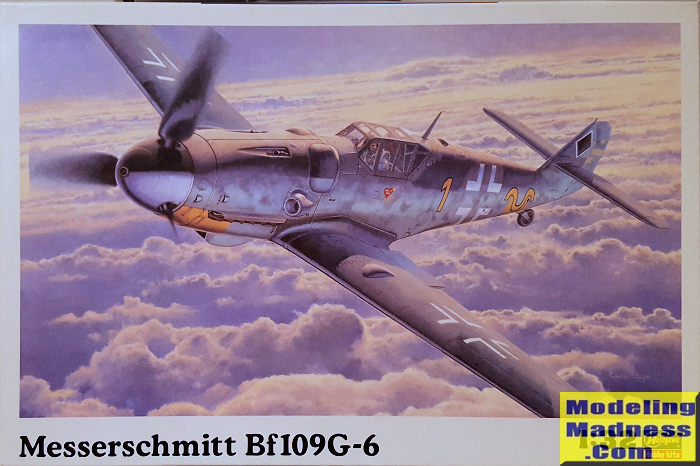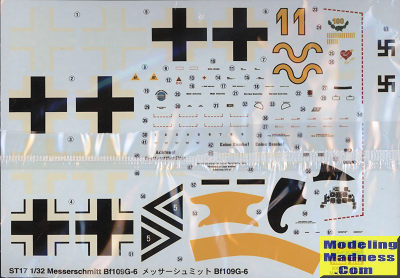
Hasegawa 1/32 Bf-109G-6
| KIT #: | 08067 (St 17) |
| PRICE: | 4200 yen when new |
| DECALS: | Two optionsNone |
| REVIEWER: | Scott Van Aken |
| NOTES: | 2001 initial release. |

| HISTORY |
The Bf-109G-6 was the most widely produced variant of Messerschmitt's 109 family. First produced in February 1943, the G-6 was introduced with the 13 mm (.51 in) MG 131s, replacing the smaller 7.92 mm (.312 in) MG 17 – externally this resulted in two sizeable Beule blisters over the gun breeches, reducing speed by 9 km/h (6 mph). Over 12,000 examples were built well into 1944 although contradictory factory and RLM records do not allow an exact tally. The G-5 with a pressurized cockpit was identical to the G-6. A total of 475 examples were built between May 1943 and August 1944. The G-5/AS was equipped with a DB 605AS engine for high-altitude missions. GM-1-boosted G-5 and G-6 variants received the additional designation of "/U2" and were clearly identifiable as they use a modified, aerodynamically cleaner, engine cowl without the usual blisters. The G-6/U4 variant was armed with a 30 mm (1.18 in) MK 108 cannon mounted as a Motorkanone firing through the propeller hub instead of the 20 mm MG 151/20. The G-6 was very often seen during 1943 fitted with assembly sets, used to carry bombs or a drop tank, for use as a night fighter, or to increase firepower by adding rockets or extra gondola-style, underwing gun pod mount ordnance.
The G-6 was continually upgraded during production with things like the Erla designed canopy, and taller fin and rudder for improved stability. Additional weapons were also carried like the WGr 21 spin stabilized rockets for use against bomber formations and a 30mm cannon to replace the 20mm version. Many of these later items were morphed into the G-14.
| THE KIT |
 After
great success with their 1/48 109 kits, Hasegawa decided to produce the series
in 1/32 scale. These kits were designed to use as much of the baseline kit to
produce other versions as possible. This includes things like separate upper
cowlings and a separate tail section for the later tails. This kit is the
earlier 109G-6 with the three piece cockpit transparency. The interior is nicely
done and you are provided a pilot figure to fit into the seat. Detail on the
inner fuselage walls is good with many additional pieces to put in place. Note
that the builder will be required to either fill some features or open up others
in order to properly dupicate the aircraft being modeled.
After
great success with their 1/48 109 kits, Hasegawa decided to produce the series
in 1/32 scale. These kits were designed to use as much of the baseline kit to
produce other versions as possible. This includes things like separate upper
cowlings and a separate tail section for the later tails. This kit is the
earlier 109G-6 with the three piece cockpit transparency. The interior is nicely
done and you are provided a pilot figure to fit into the seat. Detail on the
inner fuselage walls is good with many additional pieces to put in place. Note
that the builder will be required to either fill some features or open up others
in order to properly dupicate the aircraft being modeled.
Once the fuselage halves are joined, the cockpit section can be installed from the underside. I should mention that the instrument panel offers a decal, and also has raised detailing. The lower fuselage insert includes a nice wing spar stub for attaching the wings. The prop has separate blades and can be left off until after painting. Same for the exhaust. You are provided two upper cowling pieces depending on which decal option you are building. Landing gear is well done with sparate oleo scissors.
You are provided separate flaps and radiator exhaust flaps, though the elevators and rudder are molded in the neutral position. Slats are separate so can be posed lowered when on the ground. A standard drop tank is provided assuming you remembered to open the mounting holes in an earlier step. There is a separate windscreen, canopy, and rear quarter section so you can pose the canopy open.
 Instructions
are standard fare for Hasegawa with Gunze paint references. The two options are
both in RLM 74/75/76. The box art plane is Erich Hartmann's from 9./JG 52 and
has medium side mottling. The other is Gerhard Barkhorn's plane from II./JG 52.
It has no side mottling, but the upper fuselage colors are carried quite far
down the fuselage side. Both planes have yellow lower cowling and lower wing
tips. Decals are provided for the fuselage band. The decals are old school where
the whites are more of an off-white shade. They are well printed and while
probably still OK after 20+ years, may well be worth replacing with fresh
aftermarket ones.
Instructions
are standard fare for Hasegawa with Gunze paint references. The two options are
both in RLM 74/75/76. The box art plane is Erich Hartmann's from 9./JG 52 and
has medium side mottling. The other is Gerhard Barkhorn's plane from II./JG 52.
It has no side mottling, but the upper fuselage colors are carried quite far
down the fuselage side. Both planes have yellow lower cowling and lower wing
tips. Decals are provided for the fuselage band. The decals are old school where
the whites are more of an off-white shade. They are well printed and while
probably still OK after 20+ years, may well be worth replacing with fresh
aftermarket ones.
| CONCLUSIONS |
The introduction of the Revel kit a few years ago, took away Hasegawa's thunder when it came to large scale 109s. Sure, Trumpeter did several prior to Revell, but they are fairly expensive and really, not as well engineered. Still, the Hasegawa 109 series builds into excellent models, are fairly easy to find at a fair price and are not fiddly builds.
| REFERENCES |
https://en.wikipedia.org/wiki/Messerschmitt_Bf_109_variants#G-5,_G-6
June 2022
Copyright ModelingMadness.com. All rights reserved. No reproduction in part or in whole without express permission from the editor.
If you would like your product reviewed fairly and fairly quickly, please contact the editor or see other details in the Note to Contributors.